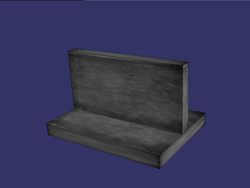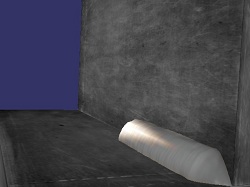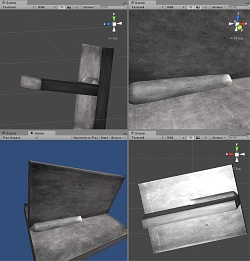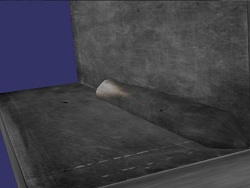Introduction
A few products recently have caught my attention for their
use of OpenSceneGraph for interesting simulation markets (surgery, manufacturing, etc).
One of these markets is the welding simulation
market. As part of my investigation into this, I decided to build a demo of some of the technology.
This section documents the relatively quick demo I made to evaluate what is involved in some aspects of
this type of simulation.
Phase 1: Base Application
Phase 1 was simply to build a basic application which showed a T-joint welding coupon. All that was needed
was a couple slab planes rendered with an appropriate texture map and lighting to give
the feeling of metal. See the image to the right.
All of the geometry, and visual representation is build programmatically. Only the texture is read from disk. All of this could be more easily done by using a modelling package, and loading the geometry using one of OpenSceneGraph's loaders, but where is the fun in that?

Simple T-Joint welding coupon.
Phase 2: Bead
This phase added a simulated
bead to the application. The following assumptions were made to keep the demo simple:
- The cross section of the bead would be based on an arc with allowable variation.
- No real efforts at this point would be made to mimic a real model for the bead.
The bead also has animation of colors per vertex to simulate cooling of the metal. It can be seen as a shift in color from white to yellow to a dull gray in the image to the right. It starts as an elliptical shape, and degrades in a linear fashion over time. Note: It is not physics based at the moment, so the cooling properties of the metal and bead are not taken into account. Instead it is a sample visualization.
The bead is textured here with the same texture as the slabs (just out of convenience.) Texture coords are computed as the bead is animated.

The bead with per vertex coloring and simple material properties.
Future Phases (for the OpenSceneGraph version):
If I find time, I would like to add the following:
- Torch representation - A nice visual representation of where the torch is located, associated lighting caused by the arc, and tie that into the bead simulation.
- Darkend helmet visualization - Mimic the view from inside the helmet.
- Add shadows once the torch is represented. The bead represents some interesting shadow accuracy challenges.

The completed weld animation.
Introduction
Game oriented tooling/libraries are gaining acceptance in other market places. Unity3D is one of
those tools. I decided to port the Welding Simulation to the Unity3D environment to see how well
it supports a simple simulation like this, and what types of flexibility it offers. The fact that
I know C# makes this transition fairly easy too.
Similar to the OpenSceneGraph version, the bead required building a C# script to generate the geometry, which was applied to the Beader GameObject. Almost all of the C++ shader logic was adapted, with minor changes to generate geometry in a manner that worked well for updating the Unity Mesh object that the script generates.

Unity3D Editor running the simulation.
- Virtual Reality Welder Training by Porter, Cote, Gifford, and Lam.
